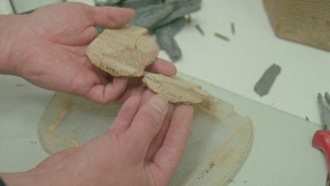
Those That, at a Distance, Resemble Another 2019
Distributed by Grasshopper Film, 12 East 32nd St., 4th Floor, New York, NY 10016
Produced by Beli Martinez and Jessica Sarah Rinland
Directed by Jessica Sarah Rinland
Streaming, 67 mins
General Adult
Experimental Film; Industries; Museums
Date Entered: 02/11/2021
Reviewed by Sam Lohmann, Reference Coordinator and Information Services Librarian, Washington State University VancouverThose That, at a Distance, Resemble Another takes the ostensible topic of museum replicas as its point of departure and offers a sensory immersion in various processes of replica making, but those seeking to learn about these processes or about the day-to-day workings of museums will have their expectations disappointed. The work appears through a series of close-up shots with no explanation or context, often depicting hands performing intricate tasks on a wide variety of materials in many locations, juxtaposed in a sequence that avoids any clear narrative. Anonymous hands, which the viewer learns to identify by a nail-polish color or a ring, handle clay, pliers, wire, brushes, a vacuum nozzle, a pencil, a scraper, plastic wrap, tape, a marker, a ruler, a saw, a clamp, scissors, sponges, q-tips, and the soundtrack gives us the –astonishing, as it turns out—range of ambient sounds associated with their work. Offscreen voices suggest the social life of these workplaces—some of them multilingual—but do not explain much about replicas, replica making, or museum work as such.
This is not an informative documentary, but it is a subtle, unpretentious, mesmerizing, and satisfying work of art. Narration and explanation seem to have been carefully avoided in order to leave space for simply looking and listening. Most of the film is taken up with tactile details of materials and gestures of craft process, accompanied by ambient sound and sometimes reminiscent of the ASMR and unboxing videos popular on YouTube. The few anecdotes offered by offscreen voices connect obliquely with what appears onscreen. At different points in the process of manufacturing a replica of a century-old elephant tusk, one worker describes the migration of elephants as seen in a television documentary; another mentions the millennia-old use of slip-casting in Peru, to make clay flutes.
The elephant tusk turns out to be one of the film’s primary subjects—perhaps one of two protagonists, along with the red-fingernailed hands of the filmmaker. Although the sequence of events is unclear, we see the tusk removed from its cast, carefully cleaned with a brush, packed in wet clay, and finally on display in the disconnected black space of a museum vitrine. In other sequences, replica clay pots are made, stone reliefs are carefully measured and sketched on tracing paper, the ivory cover of an ornate nineteenth century box is restored, and bone fragments from an archaeological site are picked from a vacuum bag. Bookending this long, immersive close-up sequence, the film opens with howler monkeys in a zoo—the text invites us to consider them as genetic “replicas” of their ancestors—and closes with wide shots of museum staff packing and moving boxes, sweeping floors, and snacking in a doorway (perhaps they could be read as reproducing their own workspace and labor power).
The sequence suggests a continuity of replications or reproductions, but the film does not explicitly propose any theory of the replica, or engage with the obvious differences between biological reproduction, artificial replication of biological forms, and replication of human-made artifacts. Rather, the idea of replication is a pretext for juxtaposing these different processes. This is artistically the right decision. Any attempt to engage with, say, Baudrillard on simulacra or Benjamin on mechanical reproduction, would destroy the film’s mysterious atmosphere and also distract from the complex richness of the moments captured here.
This film will be of interest to film scholars and students, enthusiasts of experimental documentary techniques. It may also be of interest to students of curation, archival preservation, museum studies, or ceramics, if only as a way of providing a fresh and strange perspective on those crafts.
Awards:
Special Mention, Locarno Film Festival and ZINEBI; Best Film, Festifreak; Best Cinematography, Latin/Arab Film Festival; Best Domestic Film, Documenta Madrid
Published and licensed under the Creative Commons Attribution 4.0 license. Anyone can use these reviews, so long as they comply with the terms of the license.